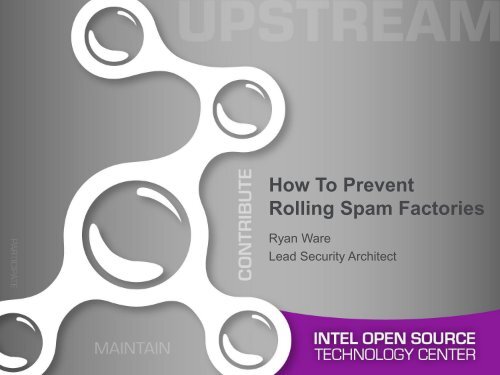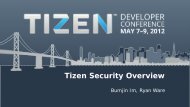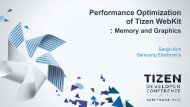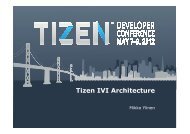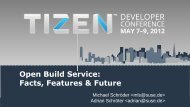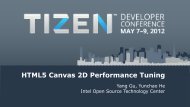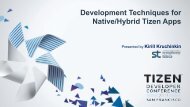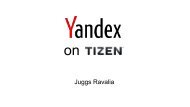How To Prevent Rolling Spam Factories
How To Prevent Rolling Spam Factories
How To Prevent Rolling Spam Factories
- No tags were found...
Create successful ePaper yourself
Turn your PDF publications into a flip-book with our unique Google optimized e-Paper software.
<strong>How</strong> <strong>To</strong> <strong>Prevent</strong><strong>Rolling</strong> <strong>Spam</strong> <strong>Factories</strong>Ryan WareLead Security Architect
Connectivity EvolutionThreat SpaceNo IP Connectivity• A/V Input• CD• DVD• Analog Radio2002 HondaOdysseyCompletely Self Contained3 SSG System Software Division
Connectivity EvolutionThreat Space• Digital Music• Traffic Data• A/V Input• USB• Bluetooth• CD• Analog Radio2011 NissanJukeMostly Self Contained4 SSG System Software Division
Connectivity EvolutionThreat Space• Internet Music• Interactive Navigation• App Store• Cellular, WiFi &Bluetooth• Arbitrary Applications• ECU Data ConnectivityAbsolutely No Containment5 SSG System Software Division
Who Are WeProtecting From?6 SSG System Software Division
Not Your Mother’s Hacker7 SSG System Software Division
Security Hackers EcosystemNational InterestSpyPersonal GainThiefFastestgrowingsegmentPersonal FameCuriosityVandalTrespasserAuthor<strong>To</strong>ols createdby expertsnow used byless-skilledattackers andcriminalsThe World <strong>To</strong>dayScript-KiddyHobbyistHackerExpert Specialist8 SSG System Software Division
Why Has Windows Been The Largest Target?Approximate Install Base EOY 2011Linux DesktopAndroid TabletiPadMac OS XiPhoneAndroid PhoneWindows 78M13M40M57M112M234M400MWindows (all) 1.25BAs a software developer trying to make money, what is your choice?Choice for malware developer is same as for any other kind of developer!One of the primary ways a malware author makes money is to create a botnetand then lease it to spammers9 SSG System Software Division
Then Why Mac OS X Flashback?7.16.96.76.56.36.15.95.75.5• Some market share increase.– Increasing numbers does mean potential for increased money• <strong>How</strong>ever, primary motivation is fame.– Apple’s $70B brand name generates news– Currently 2,640,000 Google hits for “Mac OS X Flashback malware trojan”• Apple has shipped their 3 rd security update for this issueAll this over 600,000 infected Macs; 1.05% of estimated install base10 SSG System Software Division
Magical Year of200311 SSG System Software Division
Red Hat Linux 9• Kernel 2.4.20– POSIX Thread Library (NPTL)– Beta ACPI Support– Access Control Lists & Extended Attributes– User Mode Linux• XFree86 4.3.0– Pre Xorg• GNOME 2.2– 18 Major releases old• KDE 3.1– 3.x codeline defunct• Mozilla 1.2.1– Pre Firefox• OpenSSL 0.9.7a– 12 versions old– No 0.9.7x updates since 200612 SSG System Software Division
What Are These CVE, CVSS and CWE Things?• Common Vulnerability & Exposures (CVE)– Started in 1999 by MITRE Corporation– Keeps a database of all publicly known computer security defects– Since 1999: 49,856 registered security defects• Average of 7 vulnerabilities per day• Common Vulnerability Scoring System (CVSS)– Industry standard method of assessing severity of computer securityvulnerabilities based on measurement and expert assessment.– Widely Adopted• 0.0 – 3.9: Low severity• 4.0 – 6.9: Medium severity• 7.0 – 10.0: High severity• Common Weakness Enumeration (CWE)– Sponsored by MITREHigh2265346%Medium2408448%– Formal list of software weakness types• Buffer Overflows, Structure & Validity Problems, Channel & Path Errors, etc.Low31196%13 SSG System Software Division
Wheel of Linux Kernel Fortune!!!Number ofVulnerabilities:2003:2004:2005:2006:2007:2008:2009:2010:2011:195113390637010512483Average 1.53 CVE/Week Over 9 Years14 SSG System Software Division
Linux Kernel DetailsYear # of Vuln DoSCodeExecutionOverflowMemoryCorruptionBypassSomethingGainInformationGainPrivilege2003 19 8 2 1 3 42004 51 20 5 12 5 122005 133 90 19 19 1 6 5 72006 90 61 5 7 7 5 3 32007 63 41 2 8 3 7 72008 70 44 3 17 4 4 6 102009 105 66 2 22 7 8 11 222010 124 67 3 16 7 8 30 142011 83 62 1 21 10 1 21 9<strong>To</strong>tal 738 459 40 124 36 36 91 8815 SSG System Software Division
Critical Linux Kernel Defects (CVEE Scores 8-10)• CVE-2003-0959: Denial of service or root privilege escalation– Multiple overflows in 32bit emulation• CVE-2004-1017: Arbitrary code execution– Multiple overflows in io_edgeport driver• CVE-2004-1137: Denial of service or arbitrary code execution– Multiple vulnerabilities in Internet Group Management Protocol (IGMP) handling• CVE-2006-1368: Denial of service– Buffer overflow in USB Gadget RNDIS implementation• CVE-2006-1523: Arbitrary code execution– Vulnerability in __group_complete_signal function in RCU signal handling• CVE-2006-1857: Denial of service or arbitrary code execution– Buffer overflow in Stream Control Transmission Protocol (SCTP)• CVE-2006-6535: Denial of service– dev_queue_xmit function can fail before calling local_bh_disable• CVE-2008-1673: Denial of service or arbitrary code execution– Multiple vulnerabilities in asn1 implementation• CVE-2008-3496: Arbitrary code execution– Buffer overflow in format descriptor parsing in uvc_parse_format16 SSG System Software Division
Critical Linux Kernel Defects (CVEE Scores 8-10)• CVE-2008-3915: Arbitrary code execution– Buffer overflow in NFSv4 implementation• CVE-2008-4395: Arbitrary code execution– Multiple buffer overflows in ndiswrapper module• CVE-2008-5134: Denial of service– Buffer overflow in wireless driver function lbs_process_bss• CVE-2009-0065: Denial of service– Buffer overflow in Stream Control Transmission Protocol (SCTP)• CVE-2009-4538: Denial of service– Improper checks in e1000e driver• CVE-2010-2495: Denial of service or arbitrary code execution– Improper check in L2TP driver• CVE-2010-2521: Denial of service or arbitrary code execution– Multiple buffer overflows in XDR implementation of NFS server• CVE-2010-3705: Denial of service– Improper validation of hmac_ids array of an SCTP peer• CVE-2011-2497: Denial of service or arbitrary code execution– Integer underflow in Bluetooth driver17 SSG System Software Division
This Was Just The Linux Kernel!Only 1 of the packages for our hypothetical, 2003era system!18 SSG System Software Division
<strong>How</strong> <strong>To</strong> ProtectOurselves19 SSG System Software Division INTEL CONFIDENTIAL
Reduce Attackable Surface Area• Do not include unused functionality!• Install services only used by your product• Expose only limited, well documented interfaces• Remove Debug Interfaces• There is no such thing as a “Private” interface• Included functionality not used by the product issimply additional areas for a hacker to attack20 SSG System Software Division
Least Privilege• Security Principle of only giving the needed privilege.• It is of course easier to just run everything as root!– Even have less in the way if you just run in the kernel• When your software fails, not running as root means you haveadditional protections• Very little software needs to actually mmap() to entire physicaladdress space21 SSG System Software Division
Use Compiler Defenses• -Wformat -Wformat-security -Werror=format-security– Provides warnings about potential security holes.trivial.c: In function 'main':trivial.c:16: warning: format not a string literal and no formatarguments• -fstack-protector-all– Provides canary based buffer overflow checks on the stack– Shuts application down with corrupt stack• -D_FORTIFY_SOURCE=2– Silently replaces unbounded string function calls with bounded ones– Only done where gcc can determine the buffer size• -fpic & -fpie– Generate position independent code for libraries (-fpic) and executables (-fpie).– Protects against “return to libc” attacks• NX (XD) Bit– Utilize the No eXecute (or eXecute Disable) bit where possible.– 32-bit Intel needs PAE22 SSG System Software Division
Mandatory Access Controls• Access control enforcement that supersedes Linux DiscretionaryAccess Control (DAC)• Many Different Linux Security Modules that enforce MAC– SELinux, Smack, TOMOYO, etc.• Tizen and MeeGo have utilized Simplified Mandatory Access ControlKernel (Smack)– SELinux Reference Policy more than 900,000 lines– SEAndroid Reference Policy is one quarter in size, but pressure already trying togrow it– Smack allows creation of an arbitrary number of security domains keeping thingssimple unless necessary– Example: 32 different security domains with 100 lines of Smack rules• Smack support recently added to:– Dbus– Xorg– udev23 SSG System Software Division
Systemd & Cgroups• Systemd is replacement for System V init daemonproviding more efficient startup and process control• Cgroups allows resource limits on processes or processgroups• Systemd automatically places system services andgroups of services into appropriate cgroups• Ensures misbehaving processes can be controlled andshut down• Potentially include Linux Containers-like features24 SSG System Software Division
Linux Containers (LxC)• Userland Application to configure Linux Kernel isolation features• Not a virtualization solution– Does not protect from user to kernel privilege escalation attacks• Allows isolating processes in different ways:– Process Namespace: Isolate processes from seeing one another– IPC Namespace: Ensures processes cannot share IPC’s– UID Namespace: Separate UID tables– Network Namespace: Separate network devices– UTSName Namespace: Separate host names– Mount Namespace: Separate mounted devices• Can be combined with filesystem snapshots (btrfs) to createdisposable environments25 SSG System Software Division
Integrity• Integrity Measurement Architecture– Provides runtime filesystem integrity– Keeps hash of all files in kernel memory– Kernel verifies hash on file open• Extended Verification Module– Provides offline filesystem integrity– Keeps HMAC of file extended attributes and hash– Depends on HW security subsystem (TPM)• DM-Integrity– Addition to DM-Crypt– Extends to use HMAC over files– Depends on HW security subsystem26 SSG System Software Division
Summary• The environment we’re deploying products into is not changing forthe better• Supporting a product lifetime of 10 years provides unique difficulties• Many different technologies and techniques to improve ourprotection:– Attack Surface Reduction– Least Privilege– Mandatory Access Controls– Systemd– Cgroups– Linux Containers– Integrity27 SSG System Software Division


